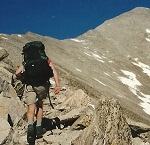Some pics of backing a bow with sinew and hide glue.
There are many ways to make hide glue, but this is how I do it. Hide glue is made from animal protein and protein is in animals. I use whitetail deer hide, hooves, sinew (tendons). I dry everything so there is no moisture in it and cut the hide and hooves into small pieces... smaller the pieces the more protein you will remove from it. I was short on supplies when I made this batch and had no hooves so I added some rawhide dog chews that had no color added, just natural rawhide from a cow.
So once it is all in the pot I will add enough water to submerge everything. Then I simmer it, some people use a higher heat but I don't. Depending on the amount you are making will depend on how long it will take. This pot took about 8 hours. As the water in the pot evaporates and it starts to get a little thicker than water (at about 5 hours) I will strain everything out so there is just liquid, throw out the stuff left in the strainer. I put the liquid back on the stove and keep simmering. I put a spoon in the fridge for 5 minutes then with another spoon I put a drop on the cold spoon. After a minute I tip the spoon to the side, if the liquid runs it is not done. If it does not move then it is done. When it is done I pour it into a container and let it gel. See the last picture:
sinew4.jpg
The bow I will be backing after I finish shaping it
bow.jpg
Putting on the sinew. I will wrap it around under the bone tip before I apply a second layer. it does not show this in the picture, but simply wrap it around the bow when the bone tip meets the wood. I wrap it and stop at about 3 inches
sinew2.jpg
The Hide glue I made is in the back left picture below. It is now a gel. To use it I break some off and add a little water, maybe a couple tablespoon's. I heat it (microwave helps) just enough to turn it back into a liquid.... only takes about 10-15 seconds in the microwave. Then it is ready to work. It will keep gelling on you as you work with it, some people add fish bladder to help postpone the gelling. I just keep warming it up. The container in the bottom right of the picture has the warm hide glue that is ready to work with. The pile of white stringy stuff and that in the clear bag is the sinew I will be putting on the bow. To make it more workable I put it in a bowl of warm water. It only takes a couple minutes in the warn water to be workable. I take out each strand one by one and cover it in the warm liquid hide glue then place it on the bow. When putting the sinew on the bow you want to lay down one long strand from the tip, then one stand about half as long, then a long one, then a short one from one side to the other. Reason for this is as you work your way down the bow you do not want any spaces between the ends of the sinew... picture when you draw back the bow the sinew will be bending on the outside of the bow, so to have it not lift and to get a good elastic effect the sinew needs to work like one large strand. Keep doing this down the bow then wrap some around the tips of the bow. Then do a second layer, this time laying it opposite... one short, one long, one short, one long and so on, and wrap some around the tips again. Let it dry, could take weeks depending on your climate, I don't touch it for a month just to be on the safe side.
sinew3.jpg
For the sinew you need to dry the tendons, and when I say dry I mean DRY, no moisture at all. Once they are dry take a hammer and give them a few whacks, not too hard but enough that you can peel them into strands. You want the strands about the width of the lead in a carpenters pencil. I use whitetail sinew because that is what I hunt and to buy the stuff is very pricey, but any kind of sinew works... sinew is sinew. I've never used cow sinew but I have been told it is very tuff and hard to strand.






 Reply With Quote
Reply With Quote



Bookmarks